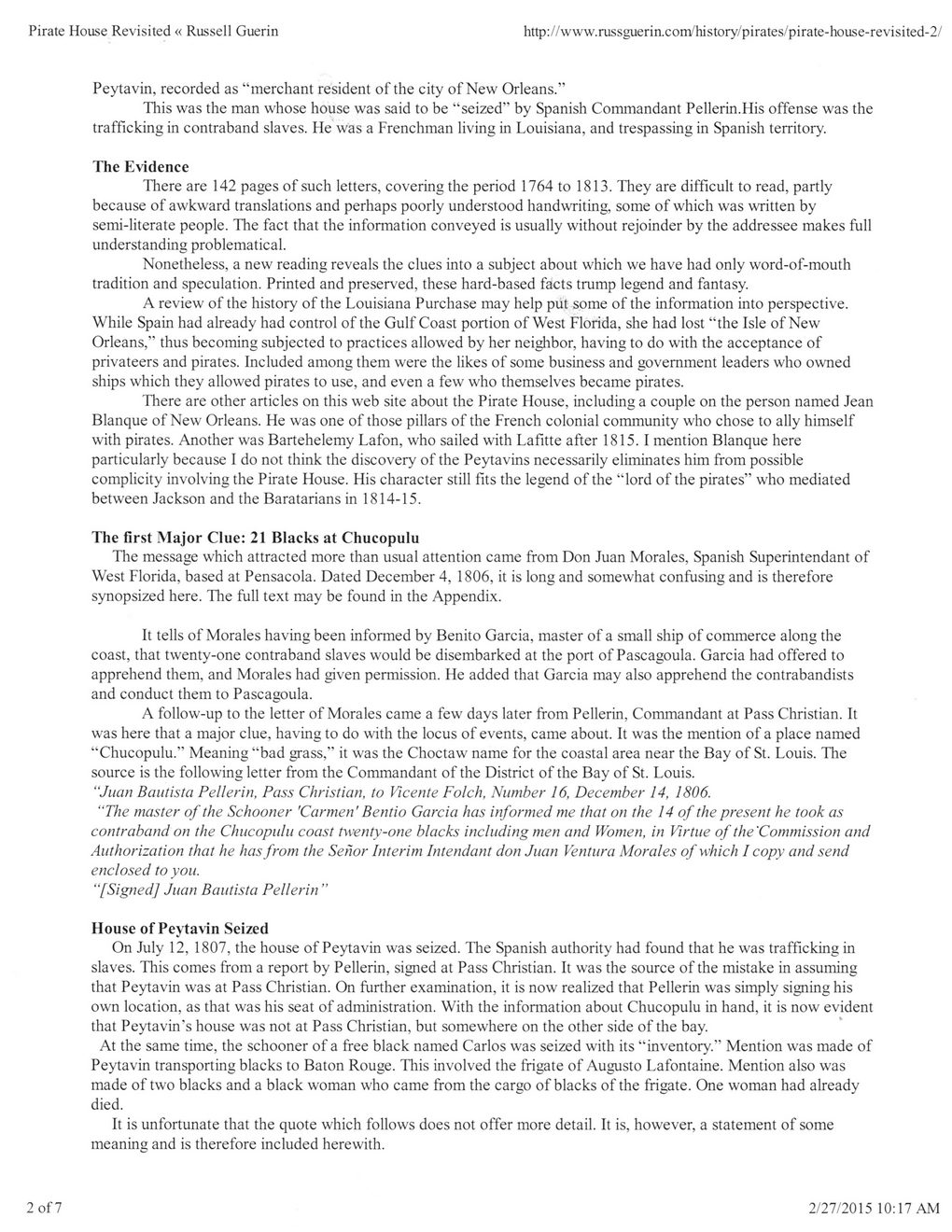This text was obtained via automated optical character recognition.
It has not been edited and may therefore contain several errors.
Pirate House Revisited « Russell Guerin http://www.russguerin.com/history/pirates/pirate-house-revisited-2/ Peytavin, recorded as “merchant resident of the city of New Orleans.” This was the man whose house was said to be “seized” by Spanish Commandant Pellerin.His offense was the trafficking in contraband slaves. He was a Frenchman living in Louisiana, and trespassing in Spanish territory. The Evidence There are 142 pages of such letters, covering the period 1764 to 1813. They are difficult to read, partly because of awkward translations and perhaps poorly understood handwriting, some of which was written by semi-literate people. The fact that the information conveyed is usually without rejoinder by the addressee makes full understanding problematical. Nonetheless, a new reading reveals the clues into a subject about which we have had only word-of-mouth tradition and speculation. Printed and preserved, these hard-based facts trump legend and fantasy. A review of the history of the Louisiana Purchase may help put some of the information into perspective. While Spain had already had control of the Gulf Coast portion of West Florida, she had lost “the Isle of New Orleans,” thus becoming subjected to practices allowed by her neighbor, having to do with the acceptance of privateers and pirates. Included among them were the likes of some business and government leaders who owned ships which they allowed pirates to use, and even a few who themselves became pirates. There are other articles on this web site about the Pirate House, including a couple on the person named Jean Blanque of New Orleans. He was one of those pillars of the French colonial community who chose to ally himself with pirates. Another was Bartehelemy Lafon, who sailed with Lafitte after 1815. I mention Blanque here particularly because I do not think the discovery of the Peytavins necessarily eliminates him from possible complicity involving the Pirate House. His character still fits the legend of the “lord of the pirates” who mediated between Jackson and the Baratarians in 1814-15. The first Major Clue: 21 Blacks at Chucopulu The message which attracted more than usual attention came from Don Juan Morales, Spanish Superintendant of West Florida, based at Pensacola. Dated December 4, 1806, it is long and somewhat confusing and is therefore synopsized here. The full text may be found in the Appendix. It tells of Morales having been informed by Benito Garcia, master of a small ship of commerce along the coast, that twenty-one contraband slaves would be disembarked at the port of Pascagoula. Garcia had offered to apprehend them, and Morales had given permission. He added that Garcia may also apprehend the contrabandists and conduct them to Pascagoula. A follow-up to the letter of Morales came a few days later from Pellerin, Commandant at Pass Christian. It was here that a major clue, having to do with the locus of events, came about. It was the mention of a place named “Chucopulu.” Meaning “bad grass,” it was the Choctaw name for the coastal area near the Bay of St. Louis. The source is the following letter from the Commandant of the District of the Bay of St. Louis. “Juan Bautista Pellerin, Pass Christian, to Vicente Folch, Number 16, December 14, 1806. “The master of the Schooner 'Carmen' Bentio Garcia has informed me that on the 14 of the present he took as contraband on the Chucopulu coast twenty-one blacks including men and Women, in Virtue of the’Commission and Authorization that he has from the Senor Interim Intendant don Juan Ventura Morales of which I copy and send enclosed to you. “[Signed] Juan Bautista Pellerin" House of Peytavin Seized On July 12, 1807, the house of Peytavin was seized. The Spanish authority had found that he was trafficking in slaves. This comes from a report by Pellerin, signed at Pass Christian. It was the source of the mistake in assuming that Peytavin was at Pass Christian. On further examination, it is now realized that Pellerin was simply signing his own location, as that was his seat of administration. With the information about Chucopulu in hand, it is now evident that Peytavin’s house was not at Pass Christian, but somewhere on the other side of the bay. At the same time, the schooner of a free black named Carlos was seized with its “inventory.” Mention was made of Peytavin transporting blacks to Baton Rouge. This involved the frigate of Augusto Lafontaine. Mention also was made of two blacks and a black woman who came from the cargo of blacks of the frigate. One woman had already died. It is unfortunate that the quote which follows does not offer more detail. It is, however, a statement of some meaning and is therefore included herewith. 2 of 7 2/27/2015 10:17 AM

Pirate House Document (015)